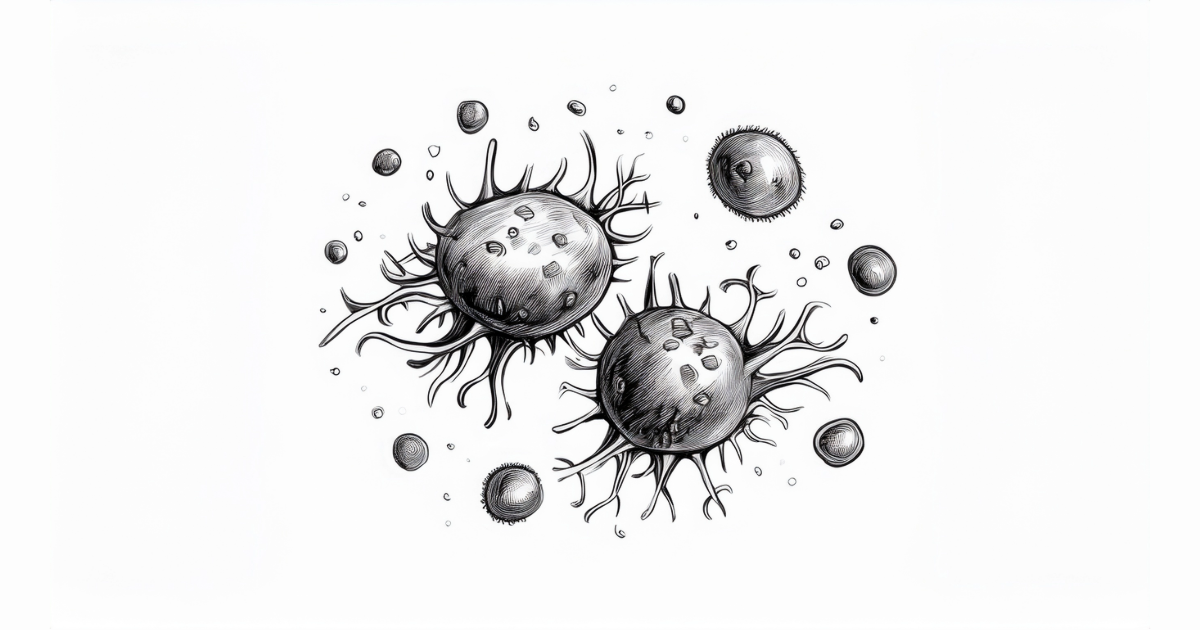IDH mutations, which are a major target of interest in acute myeloid leukemia (AML), are also present in a minority of patients with myelodysplastic syndrome (MDS). Due to the durability of response and favorable tolerability of IDH1 inhibitors, targeting these mutations in MDS has been investigated and has shown promise favorable survival outcomes a phase 1/2 study (NCT02719574) with a cohort of 22 patients receiving olutasidenib (Rezlidhia).
These patients were treated in a range of settings with olutasidenib including in combination with azacitidine or as a single agent, and in the front line or after disease relapse, resulting in an overall response rate (ORR) of 59% and a median overall survival (OS) of 27.2 months, demonstrating the potential use of a targeted therapy in MDS.1
“If you have an IDH1 mutation, that is just so important to know in MDS and should drive therapy decisions,” said Justin Watts, MD, associate professor in the hematology division at the University of Miami Miller School of Medicine.
In an interview with Targeted Oncology, Watts discussed the outcomes in this trial of patients with MDS and how to approach using an IDH1 inhibitor. In the upcoming second part of this interview, Watts discussed the significance of the long-term durability of response with olutasidenib that has been observed in some patients with AML and the next steps in research for IDH-targeted agents in AML and MDS.
Targeted Oncology: Could you describe the background for the use of olutasidenib in MDS?
Justin Watts, MD: Olutasidenib was first developed for patients with relapsed/refractory AML with an IDH1 mutation, and its approval was in that population. We had wanted to look at MDS the whole time. In the phase 2 portion of the study, we developed multiple subcohorts for other populations, including patients with MDS. What we did which I really liked was that we were quite broad, allowing both frontline and relapsed/refractory MDS or HMA [hypomethylating agent] progression, and both single-agent or combination therapy with azacitidine, which had not yet been done in MDS with an IDH1 inhibitor. That was a very good move by us at the time, because MDS is a rare disease, and this is a rare mutation. It allowed us to accrue enough patients early to get a sense of what was happening.
What were your findings in the phase 1/2 study of patients with MDS?
First, I would say that this was a very high-risk MDS population. There were no low-risk patients, and there were only a couple of intermediate-risk patients. Eighty-six percent of the 22 patients were high or very high risk, and some even had AML by new criteria like the International Consensus Classification. That being said, what we have seen in AML is that the patients who do very well tend to have lower blast counts and fewer mutations and lack of signaling pathway mutations—more resembling MDS, just their blasts are over 20%. So we weren’t surprised to see that these patients with MDS overall did very well with a 60% ORR in a mixed population, which…is greater than expected with standard-of-care azacitidine, or HMA alone, using a targeted therapy in both a single-agent and combination setting.1
The OS was equally impressive, and I think that’s due to both duration of response in the responders and the achievement of transfusion independence even in patients who don’t have a full complete response [CR] or an optimal response, which is also very important for long-term outcomes. There was notable achievement of transfusion independence, or maintenance of transfusion independence if they were independent at baseline on the study, a real lack of myelosuppression, and the [median] OS was around 27 months for the entire population.… But even when you looked at the relapsed/refractory [patients], who historically have OS on the order of 5 or 6 months, it was over 16 months in this group. So that was very encouraging.
How does the approach to treating patients with MDS differ from treating those with AML?
If you have an IDH1 mutation, that is just so important to know in MDS and should drive therapy decisions. There aren’t many targetable mutations in MDS like we see in AML. In fact, IDH1 and IDH2 are really the only 2 that cross over between both MDS and AML—being a little more common in AML than MDS, about twice as common for each one. You don’t see that with NPM1, FLT3, and other kinase mutations that may be targetable, so I think that’s notable.
It’s one of our only targeted therapy options in MDS, so arguably, an IDH1 inhibitor could be incorporated into any frontline approach with or without HMA in MDS. Even in lower-risk patients, we sometimes see them with IDH [mutations]. Some other studies have looked there, and their blood counts get better. IDH-mutated patients are going to respond better to an IDH1 inhibitor if it’s the real driver. In AML, when there’s 9 other mutations or when there’s FLT3…and the IDH is subclonal, not dominant, it’s probably not going to get you what you want, at least not as a single agent.
[In] MDS or low-blast AML, this is not always the case, but usually those are the patients who do better. Those are the patients who I think most benefit from these inhibitors. They can have that long duration of response to either single-agent IDH1 inhibition, or with the addition of HMAs, must also benefit patients with AML. As we know with the frontline ivosidenib [Tibsovo]/azacitidine data, it’s really a synergistic combination, especially if they have other significant driver mutations that need combination therapy.
How do you decide if patients should get an IDH1 inhibitor in the frontline vs relapsed MDS setting?
We’re dealing with a rare mutation in a relatively rare disease. It’s impossible to have randomized controlled trials when it’s in 3% to 5% of patients with MDS. You have to use the data you have at hand, and you have to use your judgment. When you combine the totality of the MDS data [for] ivosidenib, enasidenib [Idhifa]—which is IDH2, but basically the same pathway—and olutasidenib, all 3 of the trials had maybe 20 to 30 patients on them.1-3 You’re not going to get more than that. And when you look at those collective data, and you look at the ivosidenib/azacitidine data in patients with AML who are older, many who have secondary AML [and receive] the other IDH1 inhibitor, [and see] how good those data are in the frontline setting, why would it not be just as good in the frontline setting in a patient with high-risk MDS? [If] they have 15% blasts vs 25%, [does] that dictate their outcome?
When you have a well-tolerated targeted agent in a patient with higher-risk MDS—and with the failure of venetoclax [Venclexta] in MDS—that IDH [inhibitor] plus azacitidine [or] azacitidine/HMA combinations in the frontline make a lot of sense. They may or may not be on the guidelines. That’s shifting. It’s not approved for that, but ivosidenib is now approved for MDS, and I believe olutasidenib may be in that process.
For a low-risk patient you have other options, and a single agent may be more appropriate. For relapsed/refractory patients [with] active [disease], it depends on what prior therapy they’ve had…their age, how frail they are…. But there are some cases of relapsed/refractory [disease] where you may salvage the response to progression on HMA but continuing the HMA still provides some benefit if they’re not heavily pretreated, and adding the IDH [inhibitor] gets them over the hump. We’ve seen that scenario as well in patients on these clinical trials who basically all had prior HMA, were refractory with that, and they still responded.
I think guidelines try to reflect this. They reflect of that these agents are available, and they may not be category 1 [because] there were not randomized phase 2 trials, but we have to use what we have for these patients, especially when the drugs have such a favorable adverse event profile.
Could you describe the tolerability of IDH1 inhibitors?
Differentiation syndrome can happen even in MDS. It’s less common; it’s usually less severe. Each trial had it [roughly] once. But it is something still to know, especially in a patient with more proliferative MDS. That is the one thing I would keep in mind, and there is that potential risk to monitor for early on. That’s the most clinically significant [adverse event]. The other ones are well tolerated in terms of most AML/MDS drugs and chemotherapy, and they don’t cause excess myelosuppression. There are some drug-drug interactions and QT interval monitoring with [ivosidenib] and some hepatotoxicity, usually manageable with adjustments and so on with [olutasidenib], but those are uncommon and rarely grade 3 or severe enough to make you have to stop therapy. Sometimes the dose needs to be adjusted down, but even that’s rare.
References:
1. Cortes JE, Yang J, Roboz GJ, et al. Olutasidenib alone or combined with azacitidine in patients with mutant IDH1 myelodysplastic syndrome. Blood Adv. Published online July 16, 2025. doi:10.1182/bloodadvances.2025016718
2. DiNardo CD, Roboz GJ, Watts JM, et al. Final phase 1 substudy results of ivosidenib for patients with mutant IDH1 relapsed/refractory myelodysplastic syndrome. Blood Adv. 2024;8(15):4209-4220. doi:10.1182/bloodadvances.2023012302
3. Sebert M, Chevret S, Dimicoli-Salazar S, et al. Enasidenib (ENA) monotherapy in patients with IDH2 mutated myelodysplastic syndrome (MDS), the Ideal phase 2 study by the GFM and Emsco Groups. Blood. 2024;144(suppl 1):1839. doi:10.1182/blood-2024-201317






